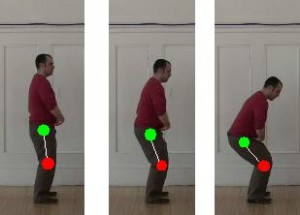Every six months or so, one of our Senior Instructors at Brookline Tai Chi tells me that he's had an amazing revelation about how to do the kwa squat.
The kwa squat is one of the very first things we teach, he's been doing Tai Chi for 40 years, and he gets new insight into it all the time. Amazing, right?
Tai Chi and Back Pain
One of the reasons we get so interested in this exercise is its power to relieve pressure on the spine and open up important joints of the body.
Here, our teacher Bruce Frantzis explains how Tai Chi works on the spine, including the effects of squatting, tucking, breathing, sinking your chi, and Bend the Bow techniques done in Tai Chi.
Even though there are many different ways to open the spine in Tai Chi, let's focus on one of the core: the kwa squat.
There's a saying in Tai Chi, which surely applies to all arts, that "high level skill is just high level basics." The deeper you go with the fundamentals, the better you get. So let's revisit the basics of the kwa squat. Specifically, we'll look at how this leads to a healthier spine and integrates the body.
The Kwa Squat
The first three levels of using the kwa will get you in the game for the more sophisticated variations you use in Tai Chi. They are:
- Folding the kwa
- Bending and Stretching from the kwa
- Pump the kwa
Because we're not really a squatting culture in the West, most people have a steep motor-learning curve when they try their first kwa squat.
Our hips tend to be frozen and we'll jam into the knees to try to lower the body.

In a proper squat, the hip joint (green dot) moves back and down, while the knee joint (red dot), rotates in place. You can also track the femur movement (white line). The knee doesn't move forward in space.
You can get a feel for the basic version by placing your knees up against the seat of a chair. When you squat, the chair shouldn't move at all. If you press into the chair, you are pressing into your knees.
Instead, you will probably feel like you're sticking your butt out. That's a good thing for this exercise and it will lead us to a key difference between a Tai Chi kwa squat and the kind of squat you would use to lift heavy weight, like in a deadlift.
In a Tai Chi kwa squat, you keep the spine straight, so the pelvis hangs like an anchor from the bottom of the spine. One of the reasons this is done is to create more space in the lumbar spine. As your sensitivity and control increase in this exercise, you can even begin to use the pulsing of the kwa to create a gentle opening at the sacroiliac joint.

Opening the sacroiliac joint makes the connection between the legs and spine much stronger, increases overall flexibility in the hips, and makes your movements much smoother.
In the process of developing this fine motor control, you need to pass through several levels of releasing and relaxing muscles and coordination. For more practice ideas, you might want to review these posts:
- How to Get More Flexible without Stretching
- Femur Bone Rhythm
- Hip Mobility
- Developing Soft Tissue in the Internal Arts
If you focus on developing this core skill, all the other qigong and Tai Chi movements that you learn are designed to multiply out the benefits. If you skip over the basics, though, the other movements just become fancy hand-waiving. Always revisit your basic training!

Share this post
Twitter
Google+
Facebook
Reddit
LinkedIn
StumbleUpon
Pinterest
Email